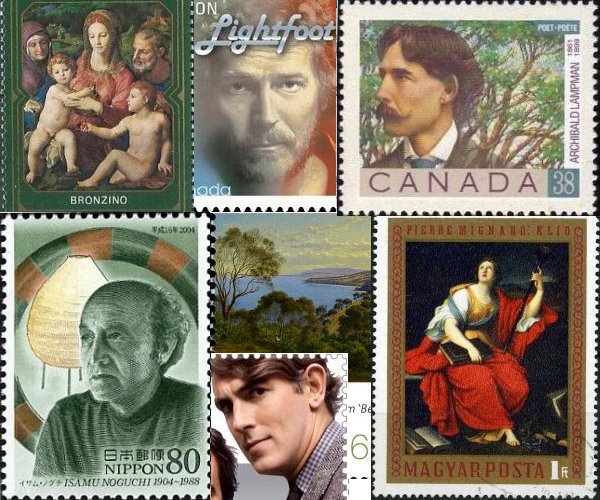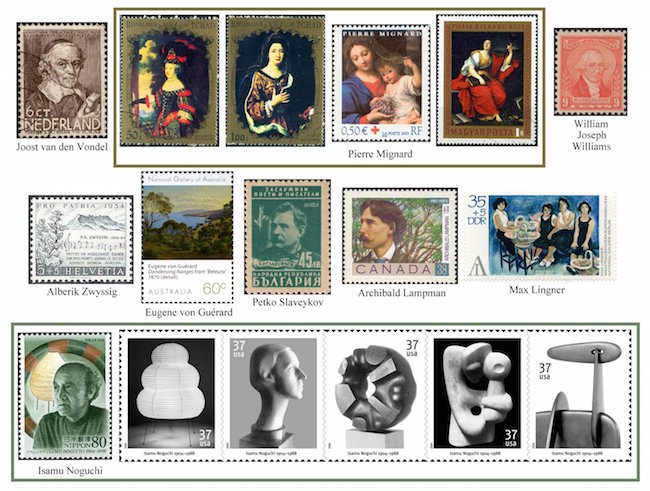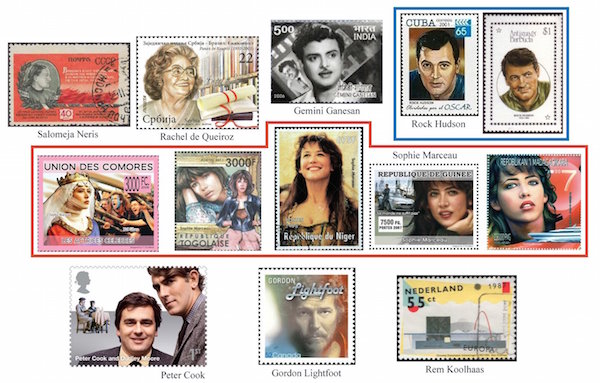The Arts on Stamps of the World — November 17
An Arts Fuse regular feature: the arts on stamps of the world.

By Doug Briscoe
The Italian Renaissance painter known as Bronzino was born on this date, as were Isamu Noguchi and several people from the entertainment world: Rock Hudson, Peter Cook, and Gordon Lightfoot among them.
Bronzino is the name by which we know the Florentine painter Agnolo di Cosimo (November 17, 1503 – November 23, 1572), patronized by the Medici as official court painter. His most famous canvas notwithstanding, the bulk of Bronzino’s work lay in portraits and religious paintings. That famous picture is Venus, Cupid, Folly and Time (c1546), seen on a stamp from Equatorial Guinea. The right foot of Cupid, at lower left of the painting (not easily seen on this particular stamp because of the cancel) has a strong association with a certain British comedy series. Let’s turn now to the portraits. Two stamps reproduce Bronzino’s portrait of his patroness, Eleonora of Toledo (1544-45). She was the wife of Cosimo I de’ Medici. The little boy with her is her son Giovanni (1543-1562), who would one day become Bishop of Pisa and a cardinal while still in his teens. Both of them, along with Giovanni’s 15-year-old brother Garzia (1543-1562), died of malaria in Pisa. An earlier Bronzino of the duchess, from about 1540, is seen on a stamp from the Czech Republic. One of Cosimo’s other children, his first, was an illegitimate daughter named Bia, or Bianca. This child, who died at about the age of six, is shown on a monochrome stamp from the Saar. Bronzino made the portrait (c1545) at Cosimo’s request three years after her death. The picture was for many years thought to have been a portrait of the first of Cosimo and Eleonora’s eleven children, Maria de’ Medici (1540 – 1557; not the famous—or infamous—one who later ruled France; this poor girl also died very young, at seventeen). (A word about the postal history of the Saar: this region of Germany issued its own stamps under Allied [French] occupation from 1947 to 1959. The Saar had also been under the administration of the League of Nations from 1920 to 1935, again with stamps distinct from those of Germany.) The stamp from Guyana shows Portrait of Ugolino Martelli (1536-37), and the last stamp in the second row is a Portrait of Guidobaldo II della Rovere (1532). The first two stamps in the final row are of two of Bronzino’s religious works, Holy Family with St. Anne and the Infant St. John (1545) and a Nativity; and the last one, a stamp of Hungary, offers another version of Venus and Cupid (c1550).

Joost van den Vondel (17 November 1587 – 5 February 1679) is said to be the most important Dutch poet and playwright of the 17th century. His play Gijsbrecht van Aemstel (1638) was produced in Amsterdam every New Year’s Day for 330 years (until 1968), and his epic poem John the Baptist (Joannes de Boetgezant, 1662) holds place as the greatest Dutch work in the form. He was born in Cologne to parents from Antwerp, who took Joost when he was about seven to Utrecht and then Amsterdam. He surprised everyone by converting to Catholicism in 1641 and, while an advocate for toleration, he satirized Calvinism in his writings. His image has appeared on Dutch currency, and Amsterdam’s largest park is named for him.
Like Bronzino, French painter Pierre Mignard (17 November 1612 – 30 May 1695) is best known for his portraits and religious and mythological paintings. He was born at Troyes into a family of artisans. At 22 he left for Rome, where he spent the next 22 years. While in that city he was hired by Nicolas Poussin to make copies of his works. (We’ll be saluting Poussin the day after tomorrow.) Mignard’s long residence in Rome led him to be nicknamed “Le Romain”, partly to distinguish him from his brother Nicolas. In 1657, apparently at the behest of Cardinal Mazarin, Mignard returned to Paris. He befriended Molière and found favor with Louis XIV, but earned the enmity of Charles Le Brun, a rivalry that ended only with Le Brun’s death in 1690. (Mignard’s brother Nicolas and nephew Paul sided with Le Brun, so there may be more here than meets the proverbial eye.) Among the portraits Mignard executed for the court are two for the wives of the King, Maria Theresa of Spain with her son the Dauphin and Françoise d’Aubigné, Marquise de Maintenon. We also see one each of the religious and mythological works with The Virgin with the Grapes (1640) and Clio (1689).

We keep to painting for the early American William Joseph Williams (November 17, 1759 – November 30, 1823), viewed as perhaps the first American portraitist. He born in New York City, his father and mother’s brothers also being painters. Williams made portraits of our first three presidents and other prominent figures of his milieu. The Washington portrait (1793) was chosen for the 9¢ denomination of a set marking Washington’s bicentenary in 1932.
Father Alberik Zwyssig (17 November 1808 – 18 November 1854) was a Cistercian monk, priest, and teacher who composed many religious and secular songs, among them the Swiss Psalm, which later became the national anthem. He wrote the music in 1841, and for many years the psalm was used as a provisional anthem, but it was not officially adopted until 1981. The stamp commemorates the one hundredth anniversary of Zwyssig’s death.
Born in Vienna, Austrian painter Eugene von Guérard (17 November 1811 – 17 April 1901) was the son of a miniaturist at court. He traveled with his father in Italy and studied further in Düsseldorf. When he was about forty he struck out for Australia in hopes of striking it rich in gold mining. Nothing came of that, but he did make many paintings of the life of the goldfields before turning to his forte, landscapes. A substantial detail of one of these is shown on the Australian stamp: Dandenong Ranges from “Beleura” (1870). (I assume “Beleura” is the name of a house?) Von Guerard (the accent aigu is omitted Down Under) lived in Australia for a full thirty years, from 1852 until 1882. Back in Europe, he lost everything in bad investments and died in poverty in London.
Normally I prefer to list artists on dates that are in accordance with the Gregorian calendar, but Bulgarian poet and folklorist Petko Slaveykov (17 November 1827 OS – 1 July 1895 OS ) is universally represented by his Old Style dates, and who am I to demur? He was born with the name Racho and changed it to Slaveykov for the nightingales (slavey) that inhabited his mother’s village. (She had died giving birth to him.) He became a teacher and began collecting folk songs and sayings, amassing over two thousand of them by 1847. In 1852 he started publishing his own writings. Slaveykov founded no fewer than fifteen (!) periodicals between the 1860s and the 1880s (they didn’t tend to last long) and was asked to edit a full translation of the Bible into Bulgarian (1871), an important milestone in establishing the vernacular in the nation’s literature. His life was not free of troubles—he was arrested a couple of times for his political activities and lost his manuscripts, along with his collection of 15,000 proverbs, in a fire. After the liberation of Bulgaria from Ottoman rule in 1878 he served in a number of prominent government positions, but for his persistence in espousing democracy he was jailed again and forbidden to teach. He died embittered. His poetry was of the patriotic, amorous, and lyric types, he wrote prose on many topics, introduced children’s literature to Bulgaria, and regathered the proverbs, this time building to a total of some 17,000.
We have next another poet, this one held in very high regard in his native Canada. Archibald Lampman (17 November 1861 – 10 February 1899) has been called “the Canadian Keats”, “perhaps the most outstanding exponent of the Canadian school of nature poets,” and “the finest of Canada’s late 19th-century poets in English.” He was born in a village in Ontario and suffered in his early childhood from rheumatic fever, which would shorten his life dramatically. Lampman tried his hand at teaching but found the job frustrating and ended up working as a postal official for the rest of his brief life. He had begun writing poetry while at college and by the later 1880s was being regularly published in major magazines both in Canada and the United States. His first book appeared in 1888. His heart weakened by his bout with rheumatic fever, he died at age 37.
Born in Leipzig, German painter and graphic artist Max Lingner (1888 – 14 March 1959) fought on all fronts in World War I and came out of the experience a committed pacifist. He worked as a farmer, then a painter, for about a decade before being advised by Käthe Kollwitz to go to Paris. Here he worked for the review Monde (1928-35) and was soon entrusted with overseeing the art department. He showed his work in a gallery for the first time in 1933 and joined the French Communist Party in 1934. He was arrested in 1939, but escaped and lived under a false name, joining the Resistance in 1943. He returned to Germany in 1949 and became a professor at the Kunsthochschule Berlin-Weißensee. Between 1950 and 1953 he created his large mural Building of the Republic for the former House of Ministries in the GDR. A detail of the central section can be seen here. The 1972 East German stamp shows his Grape Sellers (1949).
The (unmarried) parents of artist Isamu Noguchi ( November 17, 1904 – December 30, 1988) were the Japanese poet Yone Noguchi and the American writer Léonie Gilmour. He was born in Los Angeles and was taken to Japan in 1907, though his father had in the meantime married a Japanese woman and was largely absent from Noguchi’s life. At 14 he returned to America for schooling in Indiana, identifying as “Sam Gilmour”. As a young man he began his remarkable string of associations of one kind or another with many famous persons from disparate fields. He worked under Gutzon Borglum, who advised him against a career in sculpture. On a Guggenheim Fellowship he went to Paris in 1927 to study under Constantin Brâncuși, and on his return to the US he collaborated with Buckminster Fuller on a number of projects. He learned brush painting from Qi Baishi in China, met his father briefly in Tokyo, and was back in New York in the midst of the Great Depression. In these years Noguchi made a living with portrait busts, his larger projects unrealized, but in 1935 he created the first of his set designs for Martha Graham, whose head he had sculpted five years earlier. During an assignment in Mexico City he had an affair with Frida Kahlo. In the summer of 1941 he went on a cross-country road trip with Arshile Gorky. After Pearl Harbor, Noguchi was able to avoid internment for himself but try as he might had no effect on reversing the policy. Substantial recognition finally came to him in the 1950s and thereafter. Both Japan and the United States honored him on his centenary in 2004, the US with a set of five stamps showing: his industrial design for Akari lights, his portrait bust of Margaret La Farge Osborne (1937), Black Sun (1969), Mother and Child (1944-47), and Figure (1945).
Lithuanian poet Salomėja Nėris (born Salomėja Bačinskaitė-Bučienė on November 17, 1904) published her first collection in 1927 while she was still a student. This was the first of the ten or eleven slim volumes of poetry that would come out during her brief lifetime. It seems Nėris’s interest in socialism was sparked more by her attraction to a young socialist medical student than by ideology, but she became a True Believer before long, started writing for pro-Communist literary journals, and in 1940 sought entry into the Soviet Union for Lithuania. Presumably she was not averse to the subsequent occupation, and she spent the war years in the USSR. I wondered why there was a Soviet stamp for her but not a Lithuanian one. Now I see. She died of liver cancer at the age of 40 on July 7, 1945.

Frankly, I have no idea why Serbia decided to honor Brazilian writer Rachel de Queiroz (November 17, 1910 – November 4, 2003) with a postage stamp in 2011. She seems to have no connection with the Balkan country whatsoever, and there is no Wikipedia page for her in Serbo-Croatian or for that matter any in other Slavic language. I seek enlightenment. De Queiroz was born in the northeastern part of Brazil and was a journalist at 17. At 20 she had a great success with her first novel, O Quinze (The Fifteen, 1930; this was made into a movie in 2004). She had spent some of her childhood in Rio and moved there in 1939. In later life she served as Brazil’s representative at the UN.
Indian actor Ramaswamy Ganesan (17 November 1920 – 22 March 2005), a romantic lead in Tamil cinema throughout the 1950s, was better known by his stage name Gemini Ganesan. He got this name from Gemini Studios, where he worked as a production assistant and in casting for only a short time before appearing in his first screen role in 1947. He was a star by 1953 and became one of the three leading actors in the Tamil cinema of the day; unlike the other two, Sivaji Ganesan (no relation) and M.G. Ramachandran, he had no stage experience. He went on to a lengthy career with occasional forays into Hindi and other Indian movies.
Today’s representatives of the Beautiful People are Rock Hudson and Sophie Marceau. Born Roy Harold Scherer Jr. in Winnetka, Illinois, Rock Hudson (November 17, 1925 – October 2, 1985) was the American equivalent of Gemini Ganesan, a leading man whose heyday was the 1950s. He was the first major Hollywood star to die of AIDS (at 59), thus bringing widespread attention to the disease. French actress Sophie Marceau (born 17 November 1966) came before the public as a young girl in the French comedy La Boum (1980) and its sequel. She received the César Award for Most Promising Actress and went on, pretty much, to fulfill that promise, at least in France. Her appearance in Braveheart (1995), cited on the stamp from the Comoros, brought her to the attention of an international audience. A few years later she became a Bond Girl opposite Pierce Brosnan in The World Is Not Enough (1999), as indicated on stamps from Guinea and Madagascar.
The brilliant and awful Peter Cook (17 November 1937 – 9 January 1995) was nominally 25% of the unforgettable Beyond the Fringe, but he was responsible for more of the writing than Dudley Moore, Alan Bennett, or Jonathan Miller. After Fringe ended in 1964, Cook proceeded to an on-again off-again partnership with Moore through TV series and films and live performances. Alcoholism took its toll on the relationship as on Cook’s health, and he died from a gastrointestinal hemorrhage at age 57.
Just ten days ago we saw a stamp for Joni Mitchell that comes from a set of four honoring Canadian popular musicians. One of the others is Gordon Lightfoot Jr. (born November 17, 1938). Both are cited as among Canada’s finest singer-songwriters. Lightfoot turns 79 today.
Dutch architect Rem Koolhaas (born 17 November 1944) turns 73. He was born Remment Lucas Koolhaas to a distinguished family—his grandfather and a cousin were architects, and his father was a novelist whose documentary screenplays had been nominated for Academy Awards. Rem Koolhaas himself wrote a film noir screenplay in 1969 and worked as a journalist before studying architecture in London and New York. He and three others founded the Office for Metropolitan Architecture in London in 1975. The Dutch stamp from 1987 portrays the then new Netherlands Dance Theater in Scheviningen, The Hague.
I thought I should be able to come up with a stamp related in some way to Martin Scorsese, whose 75th birthday it is today, but I failed in my quest.
A graduate of the University of Massachusetts with a B.A. in English, Doug Briscoe worked in Boston classical music radio, at WCRB, WGBH, and WBUR, for about 25 years, beginning in 1977. He has the curious distinction of having succeeded Robert J. Lurtsema twice, first as host of WGBH’s weekday morning classical music program in 1993, then as host of the weekend program when Robert J.’s health failed in 2000. Doug also wrote liner notes for several of the late Gunther Schuller’s GM Recordings releases as well as program notes for the Boston Classical Orchestra. For the past few years he’s been posting a Facebook “blog” of classical music on stamps of the world, which has now been expanded to encompass all the arts for The Arts Fuse.
